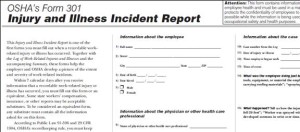Just in time for the new year, OSHA recently issued a final rule regarding the maintenance of records for recordable injury and illness.

source: OSHA.gov
You may have heard about a final rule being released by OSHA regarding recordkeeping for workplace injuries. If not, don’t panic. The final rule, issued December 19, 2016 (effective January 18, 2017), serves primarily as a clarification and reminder that recordkeeping of work-related injuries and illnesses is an ongoing requirement for employers. The official title of this latest final rule is “Clarification of Employer’s Continuing Obligation to Make and Maintain Accurate Record of Each Recordable Injury and Illness.” (December 19, 2016)
The latest rule was solely clarification of the existing regulation; according to OSHA’s recent press release (December 16, 2016), there are no major changes expected in the near future so take a deep (cue sigh of relief). No major changes aside, it is worth paying attention to their clarification to ensure that you and your team understand injury/illness recordkeeping obligations. Now, you should already have an injury record keeping system in place that is OSHA compliant. Whether you do or do not, here is a short list of the basics you need to know about the latest rule:
- Clarification – The new final rule simply states employers’ obligations, which has been standard practice for the last 40 years. According to a recent press release by OSHA, Dr. David Michaels, the Assistant Secretary of Labor for Occupational Safety and Health, stated “This rule simply returns us to the standard practice of the last 40 years. It is important to keep in mind that accurate records are not just paperwork; they have a valuable and potentially life-saving purpose.” (source: OSHA.gov).
- No Change – Although the recent amendments contain revisions to titles of several existing sections and subparts, as well as changes to text in existing provisions, nothing has been added that requires you to drastically change what you have already been doing in this area of recordkeeping. The latest final rule does not add new compliance obligations and does not require you, the employer, to make new records for any illnesses or injuries that don’t already require such documentation.
- Ongoing – As stated in the latest final rule, the duty to record an injury or illness continues for as long as the employer must keep records of the recordable injury or illness – there is no expiration for this responsibility, even in the case where the employer neglects to create the necessary records when first required to do so.
Long story short, the latest final rule is more of a formality and reiterates OSHA’s established position that an employer’s duty to record an injury or illness does not cease and continues for the full five-year record-retention period. Bear in mind, OSHA has stated the ability and right to cite employers for such recordkeeping violations for up to six months after the five-year retention period expires.
Now that you have the basics, share it with your team so that they can also perform a quick review as well as be prepared should an unfortunate workplace incident/injury arise. It is also a good time to review your safety policies and procedures. As the above listed information covers the bare bones of the latest final rule, visit OSHA.gov for more detailed information about workplace injury recordkeeping and employers’ requirements.
To gain direct access to details of OSHA’s recordkeeping requirements as they relate to injury and illness, visit their recordkeeping rule page. For more information on construction business and marketing tips, stay connected with the HBW Blog. If you would like to get ahead of construction activity and gain access to the latest permitting data in Florida, Texas, Georgia, Alabama and Oklahoma, contact HBW for more information on construction data reports and industry leads.
